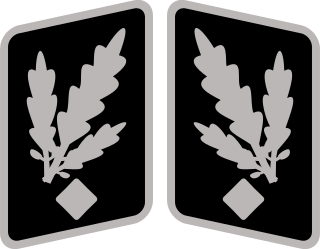
Gruppenführer was an early paramilitary rank of the Nazi Party (NSDAP), first created in 1925 as a senior rank of the SA. Since then, the term Gruppenführer is also used for leaders of groups/teams of the police, fire departments, military and several other organizations.

Obergruppenführer was one of the Third Reich's paramilitary ranks that was first created in 1932 as a rank of the Sturmabteilung (SA) and adopted by the Schutzstaffel (SS) one year later. Until April 1942, it was the highest commissioned SS rank after only Reichsführer-SS. Translated as "senior group leader", the rank of Obergruppenführer was senior to Gruppenführer. A similarly named rank of Untergruppenführer existed in the SA from 1929 to 1930 and as a title until 1933. In April 1942, the new rank of SS-Oberst-Gruppenführer was created which was above Obergruppenführer and below Reichsführer-SS.
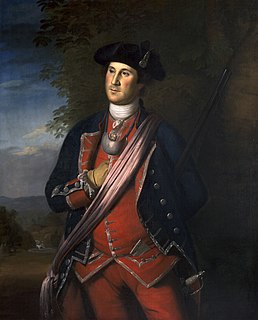
A gorget, from the French gorge meaning throat, was a band of linen wrapped around a woman's neck and head in the medieval period or the lower part of a simple chaperon hood. The term later described a steel or leather collar to protect the throat, a set of pieces of plate armour, or a single piece of plate armour hanging from the neck and covering the throat and chest. Later, particularly from the 18th century, the gorget became primarily ornamental, serving as a symbolic accessory on military uniforms, a use which has survived in some armies.

Mann, was a paramilitary rank used by several Nazi Party paramilitary organizations between 1925 and 1945. The rank is most often associated with the Schutzstaffel (SS-Mann), but also was a rank of the SA, where Mann (SA-Mann) was the lowest enlisted rank and was the equivalent of a private.
Sturmführer was a paramilitary rank of the Nazi Party which began as a title used by the Sturmabteilung (SA) in 1925 and became an actual SA rank in 1928. Translated as "storm leader or assault leader", the origins of the rank dated to the First World War when the title of Sturmführer was used by leaders of German shock troops and special action companies.
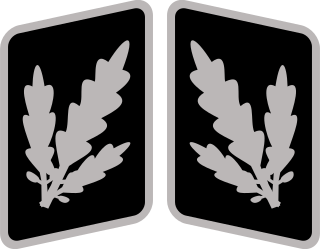
Brigadeführer was a paramilitary rank of the Nazi Party (NSDAP) that was used between the years of 1932 to 1945. It was mainly known for its use as an SS rank. As an SA rank, it was used after briefly being known as Untergruppenführer in late 1929 and 1930.

Scharführer was a title or rank used in early 20th Century German military terminology. In German, Schar was one term for the smallest sub-unit, equivalent to a "troop", "squad", or "section". The word führer simply meant "leader".

Stabschef was an office and paramilitary rank in the Sturmabteilung (SA), the paramilitary stormtroopers associated with the Nazi Party. It was a rank and position held by the operating chief of the SA. The rank is equivalent to the rank of Generaloberst in the German Army and to General in the US Army.

Sturmmann was a Nazi Party paramilitary rank that was first created in the year 1921. The rank of Sturmmann was used by the Sturmabteilung (SA) and the Schutzstaffel (SS).
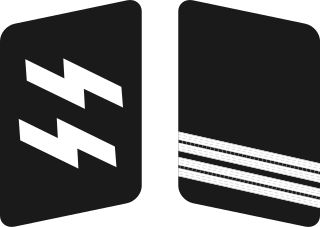
Rottenführer was a Nazi Party paramilitary rank that was first created in the year 1932. The rank of Rottenführer was used by several Nazi paramilitary groups, among them the Sturmabteilung (SA), the Schutzstaffel (SS) and was senior to the paramilitary rank of Sturmmann.
Haupttruppführer was a Nazi Party paramilitary rank that existed between the years of 1930 and 1945. Haupttruppführer was mainly used as a rank of the Sturmabteilung (SA), but was also used by the Schutzstaffel (SS) in the early days of that group's existence.

Oberscharführer was a Nazi Party paramilitary rank that existed between 1932 and 1945. Oberscharführer was first used as a rank of the Sturmabteilung (SA) and was created due to an expansion of the enlisted positions required by growing SA membership in the late 1920s and early 1930s. The SA rank of Oberscharführer was senior to Scharführer and junior to the rank of Truppführer.
In India, a senior superintendent of police in metropolitan, highly populated districts or superintendent of police in smaller districts heads the police force of a district. In districts where a senior superintendent is the head, the superintendent is the head of a large urban or rural area within a district. The superintendent is also the head of a large urban or rural area in a smaller district as well. In metropolitan areas having police commissionerate system the head of district police is called Deputy Commissioner of Police, and they hold the rank of Superintendent of Police.
Gorget patches are an insignia, paired patches of cloth or metal on the collar (gorget) of the uniform, that is used in the military and civil service in some countries. Collar tabs sign the military rank, the rank of civil service, the military unit, the office (department) or the branch of the armed forces and the arm of service.
Arbeitsleiter, German for work leader, was also a Nazi Party political rank which existed between 1939 and 1945. The rank was created to replace the former rank of mitarbeiter and was divided into three levels of arbeitsleiter, oberarbeitsleiter, and hauptarbeitsleiter.

Gemeinschaftsleiter was a Nazi Party political rank which existed between 1939 and 1945. Created primary to replace the older rank of Stützpunktleiter, the rank of Gemeinschaftsleiter was often used on the local level of the Nazi Party to denote the second in command of a municipal region, answering to a regional Nazi known by the title of Ortsgruppenleiter.

Bereitschaftsleiter was a Nazi Party political rank which existed between 1939 and 1945. There were three levels of the rank, known as Bereitschaftsleiter, Oberbereitschaftsleiter, and Hauptbereitschaftsleiter.
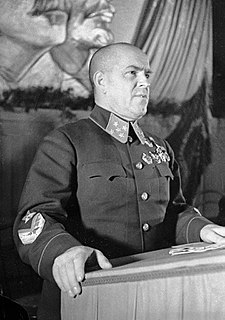
The ranks and rank insignia of the Red Army and Red Navy between 1940 and 1943 were characterised by continuing reforms to the Soviet armed forces in the period immediately before Operation Barbarossa and the war of national survival following it. The Soviet suspicion of rank and rank badges as a bourgeois institution remained, but the increasing experience of Soviet forces, and the massive increase in manpower all played their part, including the creation of a number of new general officer ranks and the reintroduction of permanent enlisted ranks and ratings.

Italian Army gorget patches are worn by all army personnel on the collars of the shirts and jackets of their service uniforms and formal uniforms. The gorget patches identify the arm, corps, or speciality within an arm or corps a soldier belongs to. Generals wear golden stars instead of a gorget patches, while army recruits wear silver stars until they are assigned to a unit after basic training. Originally made from colored cloth, respectively embroidered cloth for Granatieri, Carabinieri and general staff members, gorget patches have been made since 1973 from enamelled metal.

Lieutenant general is a three-star general officer rank in the Indian Army. It is the second-highest active rank in the Indian Army. Lieutenant generals rank above the two-star rank of Major General and below the four-star rank of General, which is held by the Chief of the Army Staff.


















